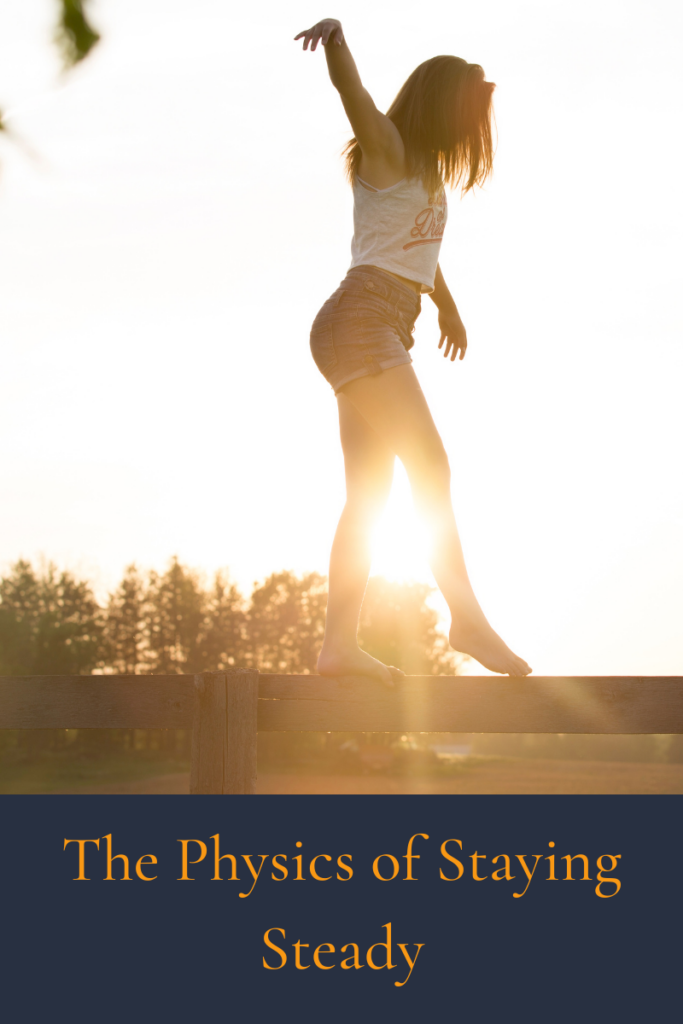Have you ever felt that balancing yourself is difficult? Ever tried standing on one foot with hands overhead and eyes closed? What do you feel? Described below are the three things that PHYSICALLY affect how you stand steady. You can utilize this information to improve your balance almost instantly – for example by increasing the base of support or moving the center of gravity within the base of support or changing the surface you’re standing on. Conversely, when trying to improve your balance, you can use your understanding of these three concepts to progress your exercises.
Base of Support: Have you ever seen a baby learning to walk? They will place their feet far from each other and use small, almost shuffling steps at first. This is to increase the base of support and reduce the time they spend on one foot.
It’s physics, isn’t it? Objects with a wider base of support are steadier than those with a small base of support. Think of a vase with a round bottom vs a flat bottom. When it comes to our bodies, being in sitting or lying down are very stable positions to be in. Change that to standing casually, most of us are still okay.
The challenge starts with a narrow base of support (Stand with feet together, or stand with one foot in front of the other, OR stand on one foot. Your body instantly starts to move and look for something to hold on with the hands. Why does our brain tell our body to do that? To INCREASE the base of support and make us feel sturdy again!
Individuals with dizziness or balance issues have difficulty walking or running for this very reason. These activities force our bodies to stand on a single leg (even if for an instant) and make us feel unsteady in the process.
So, if you want to instantly feel steady, look to change your base of support. You could either use a device (let a physical therapist) teach you how to use it properly, please!) or switch to a wider stance.
Center of Gravity: is a point in any object where the distribution of weight is equal in all directions, within a given gravitational field. In a static standing (anatomical) position, the center of gravity lies approximately in front of S2 (or the second vertebra in the sacral component of our spines). However, since human beings do not remain fixed in one position, the precise location of the COG changes from moment to moment with small movements, changes in position of the limbs, head and other body parts.
We feel well-balanced when our center of gravity stays within the base of support. Our bodies start to utilize the strategies I described above when the center of gravity shifts outside the base of support.
As the CoG moves further up/away from the supporting surface, it causes us to feel more unsteady – for example, we’re slightly more unsteady when standing with arms overhead than we are when we standing with the arms beside our bodies. The reason for this is the rise in the position of the CoG with arms overhead. Inversely, a CoG closer to the ground lends for increased stability.
When the CoG struggles to stay within the base of support, we feel unsteady. Think of when we are in tandem standing (one foot directly in front of the other), we feel more unsteady than we would standing with feet close together. In both these situations, the base of support comprises our own two feet but the CoG has a harder time staying within the BoS during tandem standing. Similarly, while squatting, we are closer to the ground but may not feel completely steady during a squat since our CoG struggles to stay within the BoS.
Supporting surface: As we learned earlier, our body awareness system relies heavily on the inputs from the surface it is in contact with. It is due to its reliance on the reaction force from the ground. Ground reaction force (GRF) is the force exerted by the ground on a body in contact with it. A person standing motionless on the ground exerts a contact force on it (the person’s weight) and at the same time an equal and opposite ground reaction force is exerted by the ground on the person (Newton’s third law of motion).
The ground reaction force allows our pressure receptors and our position sense receptors (proprioceptors) to send inputs to the brain for a matching output from the body. For example, when we stand on a pillow or a soft surface like sand, the ground reaction force is lesser than that from hard surfaces, making our feet work harder to stay steady and recruiting more of our muscles to feel stable enough to move.
Ground reaction force also changes constantly when we stand on surfaces that are uneven (or moving) – like a cobblestone path OR a moving bus/train. This makes it really challenging for our sensory systems to gauge where we are and recruits larger postural muscles to gain stability. Thus, standing on firmer, even and motionless surfaces always feels more stable than standing on soft, uneven and moving surfaces.
Have you ever experienced any balance related difficulties? Have you ever been fearful of falling? Call us for a FREE consultation at 609-726-6003!
Disclaimer
This blogpost was created for informational purposes only. This is not intended as a replacement for a physician or other healthcare professional’s advice. For medical advice specific to you, please see your healthcare professional. Your Movement Specialist, LLC or any of its members are not responsible for any injuries, losses or damages arising from the use of information provided within this blog/website
By reading this post/website, you acknowledge that you are responsible for your own health decisions. Do not use anything from any website, including this one, and try it without research and medical supervision.
None of the posts and articles on yourmovementspecialist.com may be re-printed without express written permission of the author. Your Movement Specialist will respond to written requests to re-print parts of posts and excerpts/quotes may be reprinted with attribution as long as all links are left intact.

